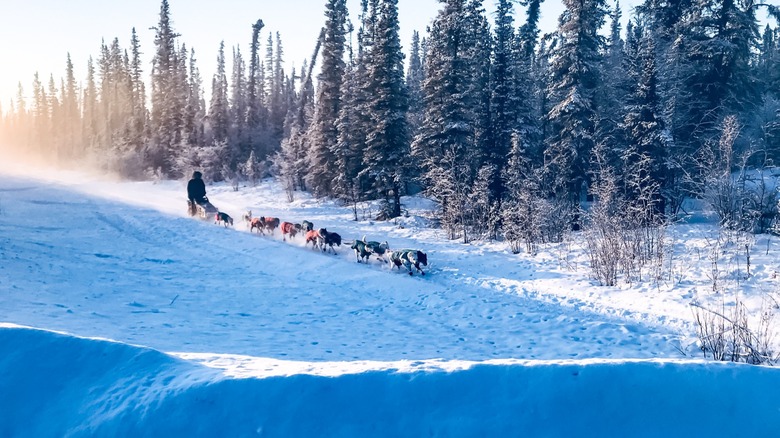One Of Alaska's Least Crowded National Parks Is Known For Stunning Sand Dunes And Wildlife
No roads, phone service, Internet, or campsites. That's how it is in Alaska's most remote national parks, and Kobuk Valley is no exception. The upside? No crowds, unless you count the half-million caribou sharing 1.8-million acres of untamed wilderness with you.
The Kobuk Valley National Park is home to breathtaking views and three stunning sets of sand dunes: Great Kobuk Sand Dunes, Little Kobuk Sand Dunes, and the Hunt River Dunes. The park lies in Northwest Alaska — just 75 miles to the east of Kotzebue — where, despite the latent threats from climate change and regional development, the caribou migrating twice a year through these lands and the resident Kuuvaŋmiut Iñupiat peoples still live together as one with nature.
Since life in this unique landscape of the Arctic tundra has gone unchanged for thousands of years, access to the park can prove challenging. However, with no roads, trails, or cellphone service, visitors to Kobuk Valley National Park are sure to enjoy this exceptional setting.
Kobuk Valley National Park is a unique natural setting
When thinking of Alaska, dramatic and exceptional landscapes filled with snowy mountains tend to come to mind, yet the ecosystem in Kobuk Valley is nothing like the traditional tundra scenery. As the boreal forests of the arctic meet with the valley's tundra — 35 miles to the north of the Arctic Circle — the park turns into mossy woodlands made up of birch trees, spruce, and willows.
Upon further exploration, however, travelers on TripAdvisor mention that "Kobuk Valley looks quite like the Sahara Desert." Specifically, the Great Kobuk Sand Dunes, Little Kobuk Sand Dunes, and Hunt River Sand Dunes — standing 100-feet tall — are an unexpected sight among the ice. Adding to the uniqueness of the valley, the dunes are considered a relic of the ice age, formed when the grinding of the rocks beneath the retreating glaciers turned into fine sand.
The Great Kobuk Sand Dunes are popular for hiking and camping in the raw wilderness. Campers are advised to come prepared with a compass, GPS, maps, or all three, as assistance is not easily available and access to the dunes is mostly done by aircraft or by float plane on the Kobuk River. Wildlife species like moose, wolves, grizzly bears, foxes, wolverines, and porcupines will accompany you during your stay alongside the iconic migrating caribou. And during the summer months, birds such as arctic terns, swans, cranes, geese, and ducks also make this wilderness their home.
Getting to and traversing through Kobuk Valley National Park
Aside from Kobuk Valley's unique sandy landscape, Onion Portage — or Paatitaaq meaning "onion" in Iñupiaq — is also worth a visit. Sitting on the banks of the Kobuk River, the portage (and river) is home to animals like salmon, sheerfish, river otters, and owls, among others. Here, subsistence hunting by the Iñupiaq is a common practice. As a historic national landmark and an important archeological site, the portage is a good place for visitors to learn about the more than 8,000 years of arctic history.
No roads have been created since the park was established in 1980 to maintain both the ecological and historical integrity of the valley. As such, flying is the only way to access the park. Taking an air taxi from Kotzebue and other nearby towns is recommended and also a great way to appreciate the one-of-a-kind scenery of Kobuk Valley. The summer months provide other means of transportation such as motorboats. However, during the winter, snowmobiles and dogsleds are the best choice. Before visiting the park, travelers should contact the Northwest Arctic Heritage Center in Kotzebue to ask about any questions they may have.
With practically nonexistent crowds (except for the caribou), the untamed wilderness and sandy dunes of Kobuk Valley make it a unique and thrilling national park experience for those backcountry campers seeking raw, wild, and unforgettable adventures in Alaska's final frontier.


